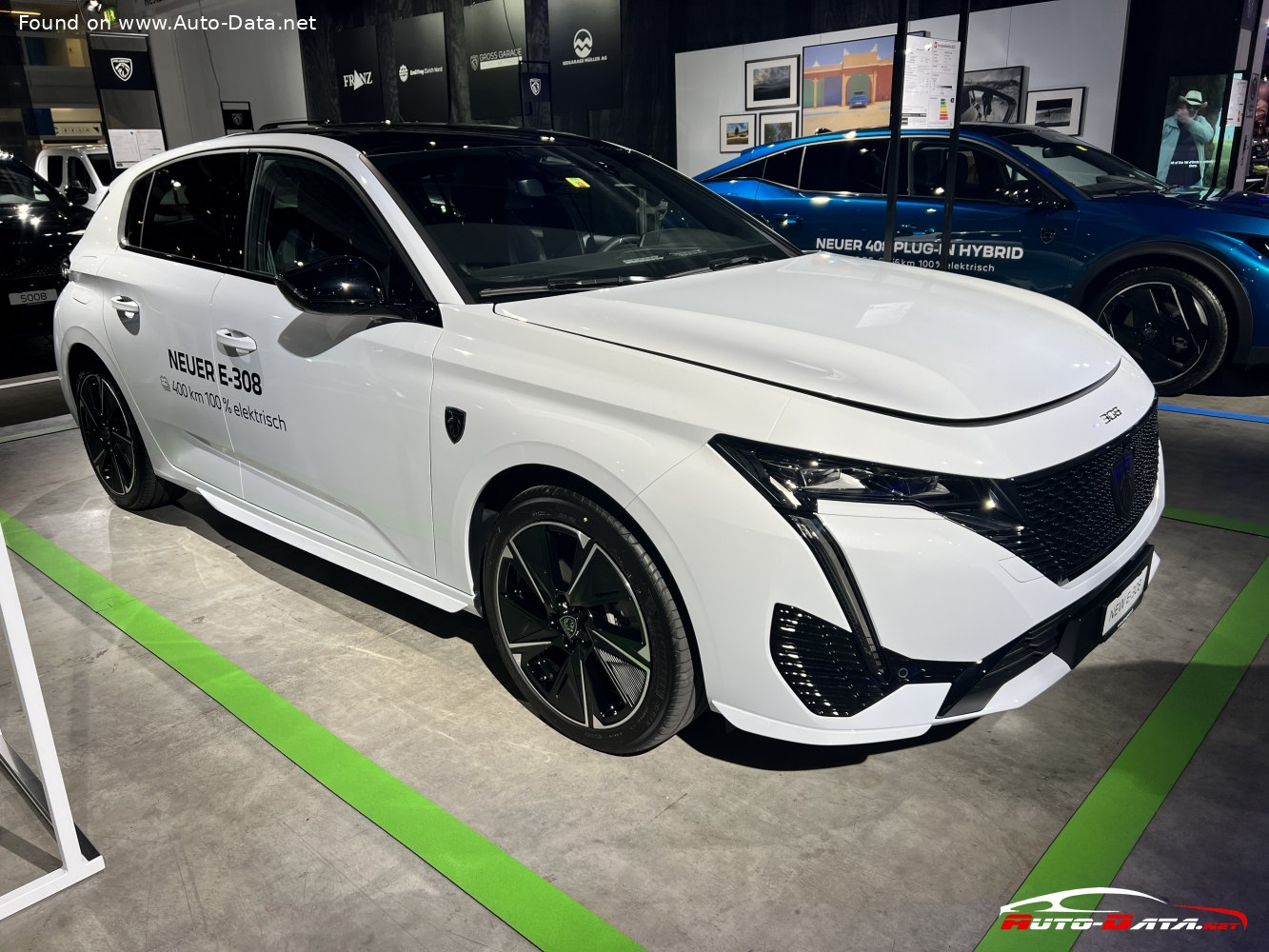2023 Peugeot 308 III (Phase I, 2021) e-308 54 kWh (156 Hp) | Specifications








| Acceleration 0 - 100 km/h | 10.5 sec |
| Acceleration 0 - 60 mph | 10 sec |
| Acceleration 0 - 62 mph | 10.5 sec |
| Fuel Type | Electricity |
| Maximum speed | 170 km/h, Electronically limited |
| Weight-to-power ratio | 10.8 kg/Hp, 92.6 Hp/tonne |
| Weight-to-torque ratio | 6.2 kg/Nm, 160.3 Nm/tonne |
Drivetrain, brakes and suspension specs
| Assisting systems | ABS (Anti-lock braking system) |
| Drive wheel | Front wheel drive |
| Drivetrain Architecture | One electric motor drives the front wheels. |
| Front brakes | Ventilated discs, 304 mm |
| Front suspension | Independent type McPherson |
| Number of gears and type of gearbox | 1 gears, automatic transmission |
| Power steering | Electric Steering |
| Rear brakes | Disc, 290 mm |
| Rear suspension | Torsion |
| Steering type | Steering rack and pinion |
| Tires size | 215/45 R18 |
| Wheel rims size | 18 |
General information
| Body type | Hatchback |
| Brand | Peugeot |
| Doors | 5 |
| Generation | 308 III (Phase I, 2021) |
| Model | 308 |
| Modification (Engine) | e-308 54 kWh (156 Hp) |
| Powertrain Architecture | BEV (Electric Vehicle) |
| Seats | 5 |
| Start of production | September, 2023 year |
Electric cars and hybrids specs
| All-electric range (WLTP) | 410-413 km |
| Average Energy consumption (WLTP) | 15-15.1 kWh/100 km |
| Battery location | Below the floor |
| Battery technology | Lithium nickel manganese cobalt oxides (Li-NMC) |
| Battery voltage | 375 V |
| Battery weight | 340 kg |
| Gross battery capacity | 54 kWh |
| Net (usable) battery capacity | 51 kWh |
Dimensions
| Front overhang | 904 mm |
| Front track | 1559 mm |
| Height | 1441 mm |
| Length | 4367 mm |
| Rear (Back) track | 1554 mm |
| Rear overhang | 788 mm |
| Wheelbase | 2675 mm |
| Width | 1852 mm |
| Width including mirrors | 2062 mm |
Space, Volume and weights
| Kerb Weight | 1684 kg |
| Max load | 426 kg |
| Max. weight | 2110 kg |
| Trunk (boot) space - minimum | 412 l |
Electric motor type Synchronous
| System power | 156 Hp @ 4070-7500 rpm. |
| System torque | 270 Nm |
Frequently Asked Questions
Here are answers to some common questions
The VIN number, also known as the VIN code, is the vehicle identification number. VIN is an abbreviation of the English term Vehicle Identification Number. The VIN number is a unique set of 17 characters that car manufacturers assign to all vehicles they produce. The VIN code can be found on various parts of the car body or in the registration documents.
In the CarVertical vehicle report, you will find the most important information about the vehicle that will allow you to assess the condition of the vehicle. In the report, you will find information such as vehicle mileage, accident data, countries of previous registrations, records from searched car databases, and much more useful information.
CarVertical reports are available immediately or can take up to a few minutes. The service is provided 24 hours a day, 7 days a week, reports are generated automatically. It basically takes as long as it takes to process your payment - the sooner the money reaches your CarVertical account, the sooner you will receive a report.
First of all, CarVertical is generally the world's first provider of VIN history reports by car code, receiving some of the data in real-time directly from the car. The information obtained in this way is the most up-to-date, which is why it is so operative. In addition, CarVertical uses BlockChain technology, so the data available to CarVertical is genuine and real.
Information about cars is obtained from many sources, including car services, national registers of various countries, insurance companies, "connected" car parks, and so on.
